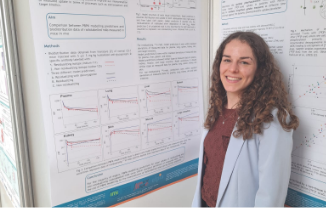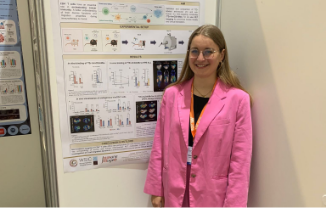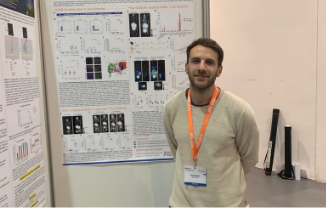Poster presentations during the EMIM 2024 in Porto
During the annual European Molecular Imaging Meeting (EMIM) in Porto, nine researchers of the Immune-Image consortium presented their promising research during the poster presentations. In this article, we will give a brief summary of each presentation.
Identification of non-competitive lead peptides for the development of PET tracers targeting PD-L1
Presenting author: Melinda Badenhorst

The immune checkpoint therapy that targets PD1-/PD-L1 (molecules expressed on cancer cells) is efficient, however, not all patients respond equally to the therapy. A suitable radiotracer could assess the PD-L1 expression in tumors before, during and after treatment, using positron emission tomography (PET), reflecting the effect of the therapy on the patient. Unfortunately, the currently developed PET tracers cannot be used for this assessment, since it is unknown how much of the drug has bound to the target, called ‘the binding epitope’. We aim to develop a PET tracer that binds PD-L1 on a different part of the molecule. Here, a methodology is introduced to identify these parts from PD-L1, called ‘lead peptides’, to which the tracer can bind.
Read more here.
On the use of physiologically based pharmacokinetic models to predict the uptake of radiolabelled monoclonal antibodies
Presenting author: Jessica E. Wijngaarden

Physiologically based pharmacokinetic (PBPK) models enable prediction of monoclonal antibody (mAb) pharmacokinetics (PK) in plasma and tissues. Recently, the platform PBPK model for mAb was extended to describe radiolabelled mAb (extended model). If model predictions capture measured radioactivity uptake data sufficiently well, PBPK modeling will allow to improve our interpretation of measured uptake in terms of parameters like extravasation and target kinetics. We aimed to describe how well PBPK modeling predicts uptake as measured in a comprehensive dataset of radiolabelled mAb in models.
Read more here.
PET imaging with model and human CD4-specific minibodies to monitor intratumoral CD4+ T cell distribution and immunotherapy success
Presenting author: Simone Blaeß

Growing evidence underscores the pivotal role of CD4+ cells in orchestrating cancer immunity. Molecular imaging of CD4+ cells offers valuable insights into the migration dynamics during cancer immunotherapy (CIT), as well as their diverse effector and regulator cell functions. In this study, we evaluated 89Zr-labeled human (h) and model (m) CD4-targeting scFv-CH3 antibody fragments (minibodies, Mbs) for in vivo positron emission tomography (PET), aiming to visualize endogenous CD4+ cell distribution in syngeneic and xenograft models and its relevance in predicting immunotherapy success.
Read more here.
Evaluation of the distribution of 64Cu-αCD206 in the tumor microenvironment using am unsupervised machine learning approach
Presenting author: Salvador G. Castaneda Vega

The tumor microenvironment (TME) has heterogeneous physical and biochemical properties that affect drug/tracer perfusion and distribution [1]. Traditional analysis of radiotracer standard uptake distribution in the tumor is cumbersome and prone to user bias. This is partly due to tumors’ inhomogeneous morphology, immune infiltration and distribution, heterogeneous tracer bioavailability in tissue, and tumor growth. In this work, we developed a simple machine learning (ML) workflow to evaluate the tumoral distribution of a PET tracer targetting tumor-associated macrophages (TAMs) and phagocytes.
Read more here.
Multimodal in vivo imaging approach to characterize CD8 T cell response against SARS-CoV-2 infection in models and non-human primates
Presenting author: Mohit Saxena

Since the outbreak of COVID-19 pandemic, it has been one of the major cause of mortality, mainly linked to immune system dysregulation particularly through activated macrophages, T-helper cells and simultaneous exhaustion of lymphocytes. The immune response associated to SARS-CoV-2 infection is still poorly understood. Thus, we aim to decipher a part of immune response by study the dynamics of change in recruitment and distribution of CD8 T-cells following infection by in vivo imaging on whole body in cynomolgus macaque (CM) by PET/CT, and on cellular scale by 2photon microscopy (2PM) in models.
Multi-modal, Multi-scale Gene Reporter for Cell Tracking
Presenting author: Eliane Brechbühl

At EMIM, Eliane presented a new approach on how infiltration of adoptively transferred cells into the bone marrow can be imaged with Near-Infrared Fluorescence and how this is relevant for multimodal CAR-T cell tracking. This approach might help develop more efficient therapies and assess patient outcomes in the future.
Read more here.
The use of a CD163-specific nanobody-based immunotracer as an imaging agent to study immunosuppressive tumor-associated macrophages
Presenting author: Yoline Lauwers

Imaging of immune cells inside the tumor microenvironment could predict the patients’ response to immunotherapy. In this study, we generated and characterized a cross-reactive nanobody (Nb) against CD163, a receptor that is specifically expressed on a subset of immunosuppressive tumor-associated macrophages (TAMs). This anti-CD163 immunotracer could be used for imaging of TAMs to predict immunotherapy response in cancer patients. The results show that we developed an immunotracer that allows visualization and monitoring of CD163+ TAMs. The immunotracer could be a promising clinical imaging agent to further study the role of TAMs, predict and/or follow-up immunotherapy responses and contribute to personalized medicine.
Read more here.
Imaging of human CD8+ cytotoxic T cells through recognition of the CD8β chain using nanobody-based immunotracers
Presenting author: Timo W.M. De Groof

The presence and activity profile of tumor-infiltrating immune cells may predict responsiveness to (immuno)therapy1, 2. More specifically, CD8+ cytotoxic T cells are believed to be the main effector cells during anti-cancer responses1. Therefore, non-invasive imaging of these cells may predict and/or follow up immunotherapy efficacy in cancer patients2. In this study, we have developed and preclinically tested novel human CD8β-targeting nanobody-based immunotracers for non-invasive nuclear SPECT and PET imaging of CD8+ T cells during anti-cancer immunotherapy.
Read more here.
Examining sex-related differences in the immune response in acute experimental colitis by positron emission tomography
Presenting author: Julia Baguña-Torres

Sex-based differences in the pathogenesis, disease course, and even response to therapy in patients with ulcerative colitis (UC) have been increasingly recognized but are still poorly understood1. Yet, sex bias is still prevalent in UC preclinical testing, leading to poor translation and replicability issues2. In this study, we aimed to examine sex-related differences in the immune response in the commonly used DSS-induced model of UC by positron emission tomography (PET) using 18F-FDG- and 89Zr-df-IAB46, a new radiotracer able to monitor the trafficking of CD4+ T cells.
Read more here.
